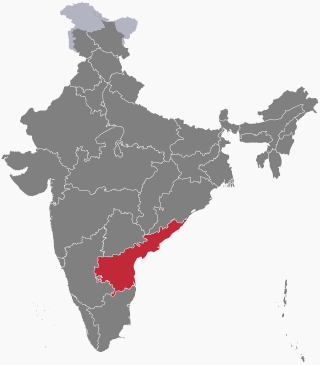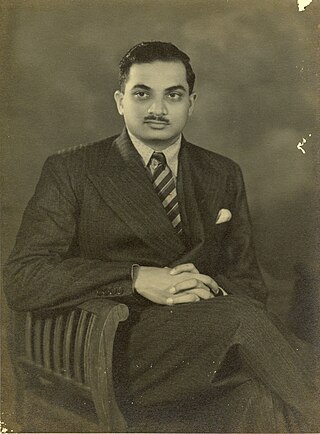
Nandamuri Taraka Rama Rao, often referred to by his initials NTR, was an Indian actor, film director, film producer, screenwriter, film editor, philanthropist and politician who served as a former Chief Minister of Andhra Pradesh for seven years over four terms. He is regarded as one of the most influential actors of Indian cinema. He starred in over 300 films, predominantly in Telugu cinema, and was referred to as "Viswa Vikhyatha Nata Sarvabhouma". Rao received three National Film Awards for co-producing Thodu Dongalu (1954) and Seetharama Kalyanam (1960) under National Art Theater, Madras, and for directing Varakatnam (1970). In 1968, The Government of India honoured him with Padma Shri, the fourth-highest civilian award, for his contributions to Indian cinema. In 2013, Rao was voted as "Greatest Indian Actor of All Time" in a CNN-IBN national poll conducted on the occasion of the Centenary of Indian Cinema.

Neelam Sanjiva Reddy was an Indian politician who served as the sixth president of India, serving from 1977 to 1982. Beginning a long political career with the Indian National Congress Party in the independence movement, he went on to hold several key offices in independent India – as Deputy Chief minister of Andhra state and the first chief minister of Andhra Pradesh, a two-time Speaker of the Lok Sabha and a Union Minister— before becoming the Indian president.
Krishikar Lok Party was a political party in the Hyderabad State, India, which existed from April to June 1951. The KLP was formed when Acharya N. G. Ranga separated from the Hyderabad State Praja Party.
Kapu is a Hindu caste primarily found in the Indian state of Andhra Pradesh. Kapus are classified as a Forward caste, and are a community of land-owning agriculturists. Historically, they also served as military generals (Nayakas) and warriors in Hindu kingdoms such as the Vijayanagara Empire. Kapus are a dominant caste of Andhra Pradesh. They are primarily present in Coastal Andhra, with a major concentration in the Godavari-Krishna delta region. Kapus commonly use the title Naidu.
Raja Sri Ravu SvetachalapatiSir Ramakrishna Ranga RaoKCIE was an Indian politician and zamindar who served as the First Minister of Madras Presidency from 5 November 1932 to 4 April 1936 and 24 August 1936 to 1 April 1937.
Telaga is a land-owning agrarian community primarily found in the Coastal Andhra region of India. Telaga is a subcaste of the Kapu community, with both terms often used interchangeably. They are classified as a Forward caste. Historically, they were a warrior caste known for their honour and bravery.
The Kisan Mazdoor Praja Party, or Praja Party for short, was a political party of India. Established in 1951, it merged with the Socialist Party to form the Praja Socialist Party in the following year. The Andhra unit of the party, however, revived the old party under the name "Praja Party" and lasted for a few more years.

The first legislative assembly Election to the Madras state based on universal adult suffrage was held in 27 March 1952. This was the first election held in Madras state after the Indian Independence. This election was officially known as the 1951 Madras State Election, even though through delays, actual voting didn't take place until early 1952.

The second legislative assembly election to the Madras state was held on 31 March 1957. This was the first election held after the linguistic reorganisation of Madras State in 1956. Indian National Congress and its leader, K. Kamaraj won the election and defeated their rival, Dravida Munnetra Kazhagam. In 1954, due to the resignation of C. Rajagopalachari, for his controversial Kula Kalvi Thittam, the leadership of Congress was contested between K. Kamaraj, and C. Subramaniam. Eventually, K. Kamaraj, won the support of the party, was elected leader and chief minister of Madras State in 1954. In a surprise move, he appointed both M. Bhaktavatsalam and C. Subramaniam, to his cabinet, allowing great unity amongst the Congress that ruled the state of Madras, for the next decade. This election saw future DMK leaders M. Karunanidhi and K. Anbazhagan win their first MLA seats in the legislative assembly.

Elections in Andhra Pradesh are conducted in accordance with the Constitution of India. The Assembly of Andhra Pradesh creates laws regarding the conduct of local body elections unilaterally while any changes by the state legislature to the conduct of state level elections need to be approved by the Parliament of India. In addition, the state legislature may be dismissed by the Parliament according to Article 356 of the Indian Constitution and President's rule may be imposed.

Kala Venkata Rao was an Indian independence activist and politician. He served as the Minister for Revenue in the governments of the Madras Presidency and Andhra Pradesh. He also served as the Minister of Finance in the latter.

The second legislative assembly election for the Madras Presidency after the establishment of a bicameral legislature by the Government of India Act of 1935 was held in 1946. The election was held after 6 years of Governor's rule starting from 1939, when the Indian National Congress government of C. Rajagopalachari resigned protesting Indian involvement in World War II. This was the last election held in the presidency - after Indian independence in 1947, the presidency became the Madras state. The election was held simultaneously with that of the Legislative Council. The Congress swept the polls by winning 163 out of 215 seats. The years after this election saw factionalism in Madras Congress party with divisions across regional and communal lines. Competition among T. Prakasam, C. Rajagopalachari and K. Kamaraj resulted in the election of Prakasam as the prime minister initially. But he was later defeated by Omandur Ramaswamy Reddiar with Kamaraj's support. In turn, Reddiar himself was ousted to make way for P. S. Kumaraswamy Raja with the support of Kamaraj.
C. Ammanna Raja or Chodagam Ammanna Raja BA was Indian freedom movement activist and Rajya Sabha member from Andhra Pradesh.

Meka Rangaiah Appa Rao shortly M. R. Appa Rao was Vice Chancellor of Andhra University, Member of Andhra Pradesh Legislative Assembly, Minister in Government of Andhra Pradesh, Member of Rajya Sabha.
Baddam Yella Reddy was an Indian communist politician from Telangana. He was one of the prominent leaders in the Telangana armed struggle against the Nizam regime.

Elections to the Legislative Assembly of the Indian state of Hyderabad were held and Sri Burgula Rama Krishna Rao took oath as First Chief Minister of Hyderabad State on 6 March 1952. 564 candidates competed for the 175 seats in the Assembly. There were 33 two-member constituencies and 109 constituencies single-member constituencies.
Elections to the Andhra State Legislative Assembly were held on 11 February 1955. 581 candidates contested for the 167 constituencies in the Assembly. There were 29 two-member constituencies and 138 single-member constituencies. The members of the first assembly (1955–62) were allowed a seven-year term. That is to say, in 1957, elections were conducted in the newly added region of Telangana alone, and then in 1962, general elections were held for the state as a whole.

In 1964, a major split occurred in the Communist Party of India. The split was the culmination of decades of tensions and factional infighting. When India became independent in 1947, differences arose of how to adapt to the new situation. As relations between the Nehru government and the Soviet Union improved, a faction that sought cooperation with the dominant Indian National Congress emerged within CPI. This tendency was led by S.A. Dange, whose role in the party hierarchy became increasingly controversial. When the Sino-Indian War broke out in 1962 Dange's opponents within CPI were jailed, but when they were released they sought to challenge his leadership. In 1964 the party was finally divided into two, with the left faction forming the Communist Party of India (Marxist). The split had a lot of regional variations. It also impacted other organizations, such as trade union and peasant movements. The split has been studied extensively by scholars, who have sought to analyze the various domestic and international factors involved.

The Socialist Party of India, also known as Socialist Party (Lohia Group), the Lohia Socialists or by its Hindi language abbreviation SOPA (सोपा), was a political party in India from 1955 to 1964. The party emerged out of a split in the Praja Socialist Party in 1955. The party was led by Dr. Ram Manohar Lohia, who had served as general secretary of the Praja Socialist Party. The Socialist Party had representation in the parliament of India as well in several state legislative assemblies. The strength of the party was concentrated in the Hindi belt, in particular after having suffered splits in Andhra Pradesh and Madras State 1958–1959. The Socialist Party would raise caste-related demands, breaking with socialist orthodoxy which had focused mainly on economic class issues. In 1964 a reunification with the remnants of the Praja Socialist Party took place, resulting in the formation of the Samyukta Socialist Party.










